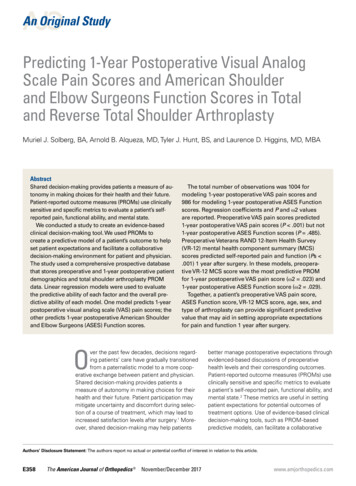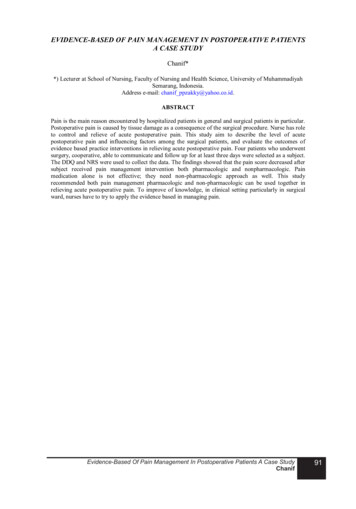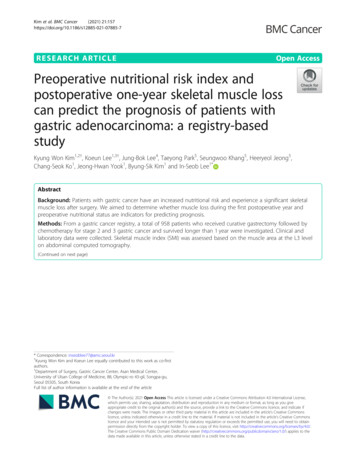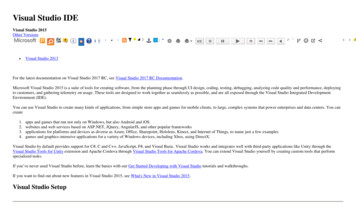
Transcription
An Original StudyPredicting 1-Year Postoperative Visual AnalogScale Pain Scores and American Shoulderand Elbow Surgeons Function Scores in Totaland Reverse Total Shoulder ArthroplastyMuriel J. Solberg, BA, Arnold B. Alqueza, MD, Tyler J. Hunt, BS, and Laurence D. Higgins, MD, MBAAbstractShared decision-making provides patients a measure of autonomy in making choices for their health and their future.Patient-reported outcome measures (PROMs) use clinicallysensitive and specific metrics to evaluate a patient’s selfreported pain, functional ability, and mental state.We conducted a study to create an evidence-basedclinical decision-making tool. We used PROMs tocreate a predictive model of a patient’s outcome to helpset patient expectations and facilitate a collaborativedecision-making environment for patient and physician.The study used a comprehensive prospective databasethat stores preoperative and 1-year postoperative patientdemographics and total shoulder arthroplasty PROMdata. Linear regression models were used to evaluatethe predictive ability of each factor and the overall predictive ability of each model. One model predicts 1-yearpostoperative visual analog scale (VAS) pain scores; theother predicts 1-year postoperative American Shoulderand Elbow Surgeons (ASES) Function scores.The total number of observations was 1004 formodeling 1-year postoperative VAS pain scores and986 for modeling 1-year postoperative ASES Functionscores. Regression coefficients and P and ω2 valuesare reported. Preoperative VAS pain scores predicted1-year postoperative VAS pain scores (P .001) but not1-year postoperative ASES Function scores (P .485).Preoperative Veterans RAND 12-Item Health Survey(VR-12) mental health component summary (MCS)scores predicted self-reported pain and function (Ps .001) 1 year after surgery. In these models, preoperative VR-12 MCS score was the most predictive PROMfor 1-year postoperative VAS pain score (ω2 .023) and1-year postoperative ASES Function score (ω2 .029).Together, a patient’s preoperative VAS pain score,ASES Function score, VR-12 MCS score, age, sex, andtype of arthroplasty can provide significant predictivevalue that may aid in setting appropriate expectationsfor pain and function 1 year after surgery.Over the past few decades, decisions regarding patients’ care have gradually transitionedfrom a paternalistic model to a more cooperative exchange between patient and physician.Shared decision-making provides patients ameasure of autonomy in making choices for theirhealth and their future. Patient participation maymitigate uncertainty and discomfort during selection of a course of treatment, which may lead toincreased satisfaction levels after surgery.1 Moreover, shared decision-making may help patientsbetter manage postoperative expectations throughevidenced-based discussions of preoperativehealth levels and their corresponding outcomes.Patient-reported outcome measures (PROMs) useclinically sensitive and specific metrics to evaluatea patient’s self-reported pain, functional ability, andmental state.2 These metrics are useful in settingpatient expectations for potential outcomes oftreatment options. Use of evidence-based clinicaldecision-making tools, such as PROM-basedpredictive models, can facilitate a collaborativeAuthors’ Disclosure Statement: The authors report no actual or potential conflict of interest in relation to this article.E358 The American Journal of Orthopedics November/December 2017 www.amjorthopedics.com
M. J. Solberg et aldecision-making environment for patient and physician. Given the present cost-containment era, andthe need for preoperative metrics that can assist inpredictive analysis of postoperative improvement,models are clearly valuable.In attempts to help patients set well-informedand reasonable expectations, physicians haveturned to PROMs to facilitate preoperative evidencebased discussions. Although PROMs have beenin use for almost 30 years, only recently have theybeen used to create tools that can aid quantitatively in the surgical decision-making process.2-6Combining physical examination findings, imagingstudies, comorbidities, and quantitative tools,such as this model, may enhance patients’understanding of their preoperative conditionand expected prognosis and thereby guide theirsurgical decisions.We conducted a study to determine whethercertain preoperative PROMs can predict 1-yearpostoperative visual analog scale (VAS) pain scoresand American Shoulder and Elbow Surgeons (ASES)Function scores in total shoulder arthroplasty (TSA)and reverse TSA (rTSA). We hypothesized that preoperative mental health status as captured by VeteransRAND 12-Item Health Survey (VR-12) mental healthcomponent summary (MCS) score and preoperativeVAS pain score would predict both VAS pain scoreand ASES Function score 1 year after surgery. Specifically, we hypothesized that a higher preoperativeVR-12 MCS score would predict less pain and betterfunction 1 year after surgery and that a higher preoperative VAS pain score would predict more pain andworse function 1 year after surgery.Take-Home Points Shared decision-making tools, such as predictive models, canhelp empower the patient to make decisions for or againstsurgery equipped with more information about the expectedoutcome. There is a role for preoperative collection of PROMs in theclinical decision-making process. Mental health state, as reported by the VR-12 MCS, is a significant predictor of postoperative pain and function as reported bythe VAS pain and ASES function scores. A significant portion of the predictive ability of this modelcomes from the fact that at 1-year postoperatively, patientsreceiving a rTSA will on average have a 3.8 point lower on ASESfunction score than those receiving a TSA (P .001, ω2 .083). Future studies to discern the role of different modalities toimprove a patient’s emotional health preoperatively will bebeneficial as the healthcare industry trends toward valuebased medicine collecting PROMs as part of reimbursementschemes.erative questionnaire was not completed. Of the1681 patients eligible for 1-year follow-up, 1225(73%) completed the 1-year postoperative questionnaire. PROMs used in the study were VAS painscore, ASES Function score, VR-12 MCS score,and Single Assessment Numerical Evaluation(SANE). Unfortunately, not all surgeons use everymeasure in the 1-year postoperative questionnaireset. Thus, in our complete models, total number ofobservations was 1004 for modeling 1-year postoperative VAS pain scores and 986 for modeling1-year postoperative ASES Function scores.MetricsMethodsThis study was approved by the Institutional ReviewBoard of Partners Healthcare. The study used theSurgical Outcome System (Arthrex), a comprehensive prospective database that stores preoperativeand 1-year postoperative patient demographics andTSA-PROM data. Surveys are emailed to all enrolledpatients before surgery and 1 year after surgery.As indicated by the Institutional Review Boards ofall participating institutions, patients in the SurgicalOutcome System have to sign a consent form topermit use of their responses in research.The database includes patient data from 42orthopedic surgeons across the United States. Allprimary TSAs and primary rTSAs in the databasewere included in this study, regardless of arthroplasty indication. Revisions were excluded. Alsoexcluded were cases in which the 1-year postop-On VAS, pain is rated from 0 (no pain) to 10 (pain asbad as it can be). Tashjian and colleagues7 estimated that the minimal clinically important difference(MCID) for postoperative VAS pain scores was 1.4in a cohort of 326 patients who had TSA, rTSA, orshoulder hemiarthroplasty. ASES Function scoreis scaled from 0 to 30, with 30 representing bestfunction.8 Wong and colleagues9 identified anMCID of 6.5 for ASES Function scores in a cohortof 107 patients who had TSA or rTSA. SANE ratingsrange from 0% to 100%, with 100% indicating thepatient’s shoulder was totally “normal.”10 VR-12MCS scores appear on a logarithmic scale, withhigher numbers representing better mental health.The population mean estimate for VR-12 MCSscores is 50.1 (SD, 11.49; overall possible range,–2.47 to 76.1).11 Our patient population’s scoresranged from 12.5 to 73.8.www.amjorthopedics.com November/December 2017The American Journal of Orthopedics E359
Predicting 1-Year Postoperative VAS Pain Scores and ASES Function Scoresmental health) would end up below certain ASESTotal scores with the risk of patients with scores inthe bottom third (worse mental health). All statistical analyses were performed with Stata (StataCorp).Statistical AnalysisSimple bivariate and multivariate linear regressionswere performed to evaluate the predictive value ofeach of the outlined PROMs. Our complete modelcontrols for patient sex, age, and type of arthroplasty. Categorical variables were dummy-coded.Both 1-year postoperative VAS pain score and 1-yearpostoperative ASES Function score were investigated as dependent variables. Regression coefficients and P and ω2 values are reported. Omegasquare represents how much of the variance in anoutcome variable a model explains, like R2, and ω2values can also be calculated for individual factorsto see how much variance a given factor accountsfor. For a simple relative risk calculation, we dividedour cohort into 3 equal-sized groups based onpreoperative VR-12 MCS scores and compared therisk that patients with scores in the top third (betterResultsTable 1 lists summary statistics for the population used in these models. Our complete modelfor predicting VAS pain score 1 year after surgeryaccounted for 8% of the variability in this painscore (ω2 .076), whereas our complete modelfor predicting ASES Function score 1 year aftersurgery accounted for 22% of the variability (ω2 .219). These models include preoperative scoresfor VAS pain, ASES Function, VR-12 MCS, SANE,age at time of surgery, sex, and type of arthroplasty as possible explanatory variables.Predicting VAS Pain Score (Table 2)Preoperative VAS pain score and VR-12 MCS scoreboth predicted 1-year postoperative VAS pain score(P .001). Preoperative ASES Function score didnot predict pain 1 year after surgery. By contrast,higher preoperative VAS pain scores were associated with higher VAS pain scores 1 year after surgery. Higher preoperative VR-12 MCS scores weresignificantly associated with lower VAS pain scores1 year after surgery, indicating that better preoperative mental health is significantly associated withbetter self-reported outcomes in terms of pain 1year after surgery. These associations remainedstatistically significant when controlling for age attime of surgery, sex, and type of arthroplasty.Preoperative VR-12 MCS score was more predictive of 1-year postoperative VAS pain score thanTable 1. Patient Sample InformationModeling 1-Year Postoperative VAS Pain Score (N 1004)Mean (SD) age at surgery, yData67.5 (9.5)% female51.4%% reverse total shoulder arthroplasty44.6%Modeling 1-Year Postoperative ASES Function Score(N 986)Mean (SD) age at surgery, y67.5 (9.5)% female51.2%% reverse total shoulder arthroplasty44.4%Abbreviations: ASES, American Shoulder and Elbow Surgeons; SD, standard deviation; VAS, visualanalog scale.Table 2. Predicting 1-Year Postoperative VAS Pain ScoreaCoefficientPω2Preoperative VR-12 MCS scoreb–.025 .001.023Preoperative VAS pain scoreb.096 .001.015Reverse total shoulder rative ASES Function score–.007.6030.000Preoperative SANE score0.000.9880.000Female.039.7280.000Explanatory VariableConstant term of regression, 3.36 (P .001). bSignificant at 99% confidence interval.Abbreviations: ASES, American Shoulder and Elbow Surgeons; SANE, Single Assessment Numerical Evaluation; VAS, visual analog scale; VR-12 MCS, Veterans RAND 12-ItemHealth Survey mental health component summary.aE360 The American Journal of Orthopedics November/December 2017 www.amjorthopedics.com
M. J. Solberg et alTable 3. Predicting 1-Year Postoperative ASES Function ScoreaCoefficientPω2Reverse total shoulder arthroplastyb–3.75 .001.083Preoperative VR-12 MCS scoreb.090 .001.029Preoperative ASES Function scoreb.197 .001.020Femaleb–1.57 .001.016Ageb.058.006.007Preoperative VAS pain score–.055.4850.010.4090Explanatory VariablePreoperative SANE scoreConstant term of regression, 14.0 (P .001). bSignificant at 99% confidence interval.Abbreviations: ASES, American Shoulder and Elbow Surgeons; SANE, Single Assessment Numerical Evaluation; VAS, visual analog scale; VR-12 MCS, Veterans RAND 12-ItemHealth Survey mental health component summary.apreoperative VAS pain score was. In other words,preoperative VR-12 MCS score accounted for morevariability in outcome for 1-year postoperative VASpain score (2.4%; ω2 .023) than preoperative VASpain score did (1.6%; ω2 .015).Predicting ASES Function Score (Table 3)By contrast, preoperative VAS pain score did notpredict 1-year postoperative ASES Function score.Preoperative ASES Function and VR-12 MCSscores both predicted 1-year postoperative ASESFunction score (P .001). Higher preoperativeASES Function scores were associated with higher1-year postoperative ASES Function scores. Inother words, reporting better shoulder function before surgery was associated with reporting bettershoulder function after surgery.An example gives a sense of the effect size associated with the coefficient for preoperative ASESFunction score. Our model predicts that, comparedwith a patient who reports 5 points lower on preoperative ASES Function (which ranges from 0-30),a patient who reports 5 points higher will report onaverage about 1 point higher on 1-year postoperative ASES Function. As in the model for postoperative pain, these associations with preoperativefunction and mental health scores held whencontrolling for age, sex, and type of arthroplasty.As in the postoperative pain model, preoperativeVR-12 MCS score was more predictive of 1-yearpostoperative ASES Function score than preoperative ASES Function score was. Preoperative VR-12MCS score accounted for more of the variationthat our model predicts (ω2 .029) than preoperative ASES Function score did (ω2 .020). Wewww.amjorthopedics.com Table 4. Relative Risk for Low vs High Preoperative VR-12 MCS ScoreaASES Total ScoreRR95% CI for RR702.38 times1.74-3.25801.79 times1.46-2.19901.34 times1.10-1.64Increased RR associated with low VR-12 MCS score (bottom third of cohort) vs high score (top third).All 3 RR values were significant at 95% CI.Abbreviations: ASES, American Shoulder and Elbow Surgeons; CI, confidence interval; RR, relative risk;VR-12 MCS, Veterans RAND 12-Item Health Survey mental health component summary.a compared the risk that patients with high preoperative VR-12 MCS scores (top third of cohort) wouldend up with ASES Total scores below 70, below80, or below 90 with the risk of patients with lowpreoperative VR-12 MCS scores (bottom third).Results appear in Table 4.A significant part of the predictive ability of ourmodel for postoperative ASES Function scoresstems from the fact that a patient who undergoesrTSA (vs TSA) is predicted to have an ASES Function score 3.8 points lower 1 year after surgery(P .001, ω2 .083). With type of arthroplastycontrolled for, female sex is associated with anASES Function score 1.6 points lower 1 year aftersurgery (P .001, ω2 .016).Preoperative SANE score did not predict 1-yearpostoperative VAS pain score or ASES Function score.In addition, when our complete model was run with1-year postoperative SANE score as the dependentvariable, preoperative SANE score did not predict1-year postoperative SANE score. Our data provideno supporting evidence for the use of SANE scoresfor predictive modeling for shoulder arthroplasty.November/December 2017The American Journal of Orthopedics E361
Predicting 1-Year Postoperative VAS Pain Scores and ASES Function ScoresTable 5. SummaryDependent Variables 1 Year After SurgeryaExplanatory VariableVAS Pain ScoreASES Function ScorePreoperative VAS pain score N/SPreoperative VR-12 MCS score Preoperative ASES Function scoreN/S Reverse total shoulder arthroplasty Age at time of surgery FemaleN/S Preoperative SANE scoreN/SN/SaPlus sign, positively correlated/associated; minus sign, negatively correlated/associated; N/S, not significantly associated.Abbreviations: ASES, American Shoulder and Elbow Surgeons; SANE, Single Assessment Numerical Evaluation; VAS, visual analog scale; VR-12 MCS, Veterans RAND 12-ItemHealth Survey mental health component summary.DiscussionTable 6. Example Patient 1aPreoperative VAS pain score8Preoperative ASES Function score10Preoperative VR-12 MCS score30Preoperative SANE score50Age65Female (1 for yes, 0 for no)1Reverse total shoulder arthroplasty (1 for yes, 0 for no)1Preoperative theoretical ASES Total score27Predicted 1-year postoperative VAS pain score, 2.4; predicted 1-year postoperative ASES Functionscore, 17.2; predicted theoretical ASES Total score, 66.8.Abbreviations: ASES, American Shoulder and Elbow Surgeons; SANE, Single Assessment NumericalEvaluation; VAS, visual analog scale; VR-12 MCS, Veterans RAND 12-Item Health Survey mental healthcomponent summary.aTable 7. Example Patient 2aPreoperative VAS pain score6Preoperative ASES Function score18Preoperative VR-12 MCS score62Preoperative SANE score60Age58Female (1 for yes, 0 for no)0Reverse total shoulder arthroplasty (1 for yes, 0 for no)0Preoperative theoretical ASES Total score50aPredicted 1-year postoperative VAS pain score, 0.98; predicted 1-year postoperative ASES Functionscore, 26.8; predicted theoretical ASES Total score, 89.7.Abbreviations: ASES, American Shoulder and Elbow Surgeons; SANE, Single Assessment NumericalEvaluation; VAS, visual analog scale; VR-12 MCS, Veterans RAND 12-Item Health Survey mental healthcomponent summary.E362 The American Journal of Orthopedics November/December 2017 We prospectively gathered data to determinewhich factors would predict patient subjectiveoutcomes of primary TSA and primary rTSA. Wehypothesized that preoperative VR-12 MCS scoresand preoperative VAS pain scores would predictpostoperative pain and function as measured withthose PROMs. Second, we hypothesized thatbetter preoperative mental health (as measuredwith VR-12 MCS scores) would predict lowerpostoperative pain (VAS pain scores) and betterpostoperative function (ASES Function scores).Third, we hypothesized that higher preoperativepain (VAS pain scores) would correlate with higherpostoperative pain (VAS pain scores) and worsepostoperative function (ASES Function scores).Our main goal is to provide patients andsurgeons with a predictive model that generatesinsights into what patients can expect after surgery. This model is not intended to be a screeningtool for operative indications, but a clinical tool forhelping set expectations.Our results showed that patients with more painbefore surgery were more likely to have more pain1 year after surgery—confirming the hypothesizedrelationship between pain before and after surgery.Contrary to the hypothesis, however, degree of painbefore surgery was not associated with function1 year after surgery. Our mental health hypothesiswas confirmed: Patients with better preoperativemental health scores had on average less pain andbetter function 1 year after surgery. Not surprisingly,our model demonstrated that patients with betterself-reported function before surgery had betterself-reported function after surgery. Patient-reportedfunction before surgery did not significantly affecthow much pain the patient had 1 year after surgery.www.amjorthopedics.com
M. J. Solberg et alAlthough we did not hypothesize about the role offunction in predicting 1-year outcomes, function isa significant factor to be considered when settingpatient expectations regarding shoulder arthroplastyoutcomes (Table 5).Although the effect sizes of each analyzed factorare small, together our models for 1-year postoperative pain and function provide significant insightinto patients’ likely outcomes 1 year after TSA andrTSA. Table 6 and Table 7 list preoperative PROMsand baseline characteristics for 2 sample patientsand the corresponding 1-year postoperative resultsthey should expect according to our model. Patient1 (Table 6) achieves a theoretical ASES Total scoreof 67, and patient 2 (Table 7) achieves a theoreticalASES Total score of 90. During discussion of surgical options, these patients should be counseleddifferently. If patient 1 expects a “normal” shoulderafter surgery, he or she likely will be disappointedwith the outcome. Tools such as those providedhere can contribute to evidence-based discussionsand well-informed decision making.Many studies have found that mental healthcorrelated with pain and function during recoveryfrom orthopedic trauma.12-18 For example, Wylieand colleagues19 found that preoperative mental health, as measured with the 36-Item ShortForm Health Survey (SF-36) MCS score, predictedpatient-reported pain and function in the settingof rotator cuff injury, regardless of treatment type(operative, nonoperative). Others have found thatmental health may play a role in how patients report their pain and function on various PROMs.20,21Modalities for improving patients’ emotional healthbaseline may even become a preoperative requirement as the healthcare industry moves toward valuebased medicine and collection of patient-relatedoutcomes as part of reimbursement schemes.By contrast, some studies have found thatpreoperative mental health did not predict postoperative outcomes. For example, Kennedy and colleagues22 found that preoperative mental health (asmeasured with SF-36 MCS scores) did not predictfunctional outcome in patients with ankle arthritistreated with ankle arthroplasty or arthrodesis.Likewise, Styron and colleagues23 found no correlation between preoperative mental health (SF-12MCS scores) and postoperative mental health andfunction in TSA. Their findings contradict those ofthe present study and many other studies.12-18 Thecontradiction in findings demonstrates the needfor well-designed, sufficiently powered studies ofthe link between preoperative mental health andpostoperative outcome. Our study, with its largesample and heterogeneous population, is a start.Two other groups (Simmen and colleagues,18Matsen and colleagues24) have attempted todevelop a model predicting outcomes of shoulderarthroplasty. Simmen and colleagues18 estimatedthe probability of “treatment success” 1 year afterTSA. Their model had 4 factors predictive of patientoutcomes. Previous shoulder surgery and age over75 years were significantly associated with lowerprobability of success, whereas higher preoperative SF-36 MCS scores and higher preoperativeDASH (Disabilities of the Arm, Shoulder, and Hand)Function scores were associated with higherprobability of success. The authors deemed TSAsuccessful if the patient achieved a Constant scoreof 80 out of 100. Their model predicts probabilityof TSA “success,” whereas our models predictparticular outcome scores. Both their results andours support the hypothesis that preoperativemental health and function scores can predict howwell a patient fares after surgery. Simmen andcolleagues18 based their model on a cohort of only140 patients and reported a 33.6% success rate(47/140 surgeries).Matsen and colleagues24 used a 1-practicecohort of 337 patients who underwent different types of arthroplasties, including TSA, rTSA,hemiarthroplasty, and ream-and-run arthroplasty.Although their focus was not preoperative PROMspredicting postoperative PROMs, they used theSimple Shoulder Test (SST) baseline score as apredictive variable. They found that 6 baselinecharacteristics—American Society of Anesthesiologists class I, shoulder problem unrelated towork, no prior shoulder surgery, glenoid type otherthan A1, humeral head not superiorly displaced onanteroposterior radiograph, and lower baseline SSTscore—were statistically associated with betteroutcomes, and they developed a model driven bythese characteristics. They urged other investigators to perform the same kind of analysis with larger patient populations from multiple practices. Oneof the strengths of our study is its large patientpopulation. We collected data on 1004 patientsfor modeling 1-year postoperative VAS pain scoresand 986 patients for modeling 1-year postoperativeASES Function scores.Our study had several limitations. First, its datacame from a 42-surgeon database, and there maybe variations in how these surgeons enroll patientsin the registry. If some surgeons did not enroll alltheir surgical patients, our sample could have beenwww.amjorthopedics.com November/December 2017The American Journal of Orthopedics E363
Predicting 1-Year Postoperative VAS Pain Scores and ASES Function Scoressubject to selection bias. Second, in developingour model, we used only patient characteristicsthat were available in the database. On the otherhand, the heterogeneity of the surgeon samplelended external validity to the model. A third limitation was that the model always predicts betterpain and function outcomes after TSA than afterrTSA. In other words, it does not consider whetherTSA is appropriate for a particular patient. Instead,it predicts 1-year shoulder arthroplasty outcomes.Our goal here is not to provide outcomes information or a surgical screening tool, but to reporton our use of a simple data-driven tool for settingexpectations. When appropriate data becomeavailable, tools like this should be expanded to predict longer-term shoulder arthroplasty outcomes.We need more studies that combine preoperativePROMs, more baseline clinical and patient characteristics (following the Matsen and colleagues24model), and large sample sizes.ConclusionThe educational models presented here can helppatients and surgeons learn what to expect aftersurgery. These models reveal the value in collecting preoperative subjective PROMs and showhow a quantitative tool can help facilitate shareddecision-making and set patient expectations. Separately, the effect size of each factor is small, buttogether a patient’s preoperative VAS pain score,ASES Function score, VR-12 MCS score, age, sex,and type of arthroplasty can provide informationpredictive of the patient’s self-reported pain andfunction 1 year after surgery.3.4.5.6.7.8.9.10.11.12.13.14.Ms. Solberg is a Research Assistant; Dr. Alqueza is Attending Surgeon, Hand and Upper Extremity Service, Department of Orthopedic Surgery; Mr. Hunt is a ResearchAssistant; and Dr. Higgins is Chief, Sports Medicine andShoulder Service, Boston Shoulder Institute, Brighamand Women’s Hospital, Boston, Massachusetts.Address correspondence to: Laurence D. Higgins, MD,MBA, Boston Shoulder Institute, Brigham and Women’sHospital, 15 Francis St, Boston, MA 02115 (tel, 617-7355887; fax, 617-730-2810; email, ldhiggins@bwh.harvard.edu).Am J Orthop. 2017;46(6):E358-E365. Copyright FrontlineMedical Communications Inc. 2017. All rights reserved.References1.2.Stacey D, Légaré F, Col NF, et al. Decision aids for peoplefacing health treatment or screening decisions. CochraneDatabase Syst Rev. 2014;(1):CD001431.Berliner JL, Brodke DJ, Chan V, SooHoo NF, Bozic KJ. Canpreoperative patient-reported outcome measures be used toE364 The American Journal of Orthopedics November/December 2017 15.16.17.18.19.20.predict meaningful improvement in function after TKA? ClinOrthop Relat Res. 2017;475(1):149-157.Berliner JL, Brodke DJ, Chan V, SooHoo NF, Bozic KJ. JohnCharnley award: preoperative patient-reported outcome measures predict clinically meaningful improvement in functionafter THA. Clin Orthop Relat Res. 2016;474(2):321-329.Wong SE, Zhang AL, Berliner JL, Ma CB, Feeley BT. Preoperative patient-reported scores can predict postoperativeoutcomes after shoulder arthroplasty. J Shoulder ElbowSurg. 2016;25(6):913-919.Werner BC, Chang B, Nguyen JT, Dines DM, Gulotta LV.What change in American Shoulder and Elbow Surgeonsscore represents a clinically important change after shoulderarthroplasty? Clin Orthop Relat Res. 2016;474(12):2672-2681.Glassman SD, Copay AG, Berven SH, Polly DW, Subach BR, Carreon LY. Defining substantial clinical benefitfollowing lumbar spine arthrodesis. J Bone Joint Surg Am.2008;90(9):1839-1847.Tashjian RZ, Hung M, Keener JD, et al. Determining the minimal clinically important difference for the American Shoulderand Elbow Surgeons score, Simple Shoulder Test, and visualanalog scale (VAS) measuring pain after shoulder arthroplasty. J Shoulder Elbow Surg. 2017;26(1):144-148.Michener LA, McClure PW, Sennett BJ. American Shoulderand Elbow Surgeons Standardized Shoulder AssessmentForm, patient self-report section: reliability, validity, andresponsiveness. J Shoulder Elbow Surg. 2002;11(6):587-594.Wong SE, Zhang AL, Berliner JL, Ma CB, Feeley BT. Preoperative patient-reported scores can predict postoperativeoutcomes after shoulder arthroplasty. J Shoulder ElbowSurg. 2016;25(6):913-919.Williams GN, Gangel TJ, Arciero RA, Uhorchak JM, Taylor DC.Comparison of the Single Assessment Numeric Evaluation method and two shoulder rating scales. Outcomesmeasures after shoulder surgery. Am J Sports Med.1999;27(2):214-221.Selim AJ, Rogers W, Fleishman JA, et al. Updated U.S. population standard for the Veterans RAND 12-Item Health Survey(VR-12). Qual Life Res. 2009;18(1):43-52.Ayers DC, Franklin PD, Ploutz-Snyder R, Boisvert CB. Totalknee replacement outcome and coexisting physical andemotional illness. Clin Orthop Relat Res. 2005;(440):157-161.Ayers DC, Franklin PD, Trief PM, Ploutz-Snyder R, Freund D.Psychological attributes of preoperative total joint replacement patients: implications for optimal physical outcome.J Arthroplasty. 2004;19(7 suppl 2):125-130.Barlow JD, Bishop JY, Dunn WR, Kuhn JE; MOON ShoulderGroup. What factors are predictors of emotional health inpatients with full-thi
RAND 12-Item Health Survey (VR-12) mental health component summary (MCS) score and preoperative . 3.36 (P .001). bSignificant at 99% confidence interval. Abbreviations: ASES, American Shoulder and Elbow Surgeons; SANE, Single Assessment Numerical Evaluation; VAS, visual analog scale; VR-12 MCS, Veterans RAND 12-Item .










